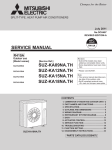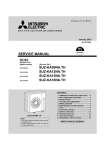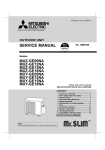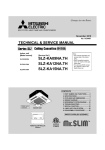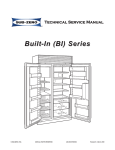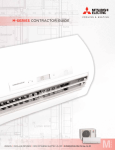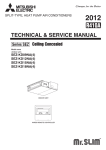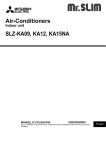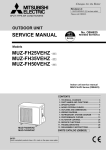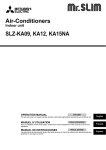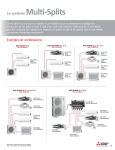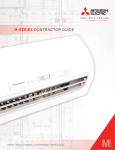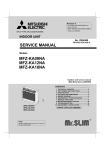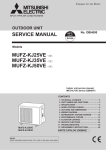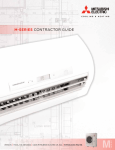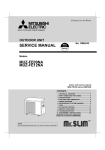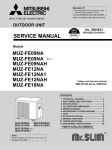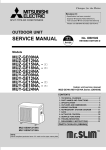Download SUZ Service Manual
Transcript
SPLIT-TYPE, HEAT PUMP AIR CONDITIONERS May 2014 No.OCH467 REVISED EDITION-C HFC utilized R410A SERVICE MANUAL R410A Outdoor unit [Model Names] SUZ-KA09NA SUZ-KA12NA SUZ-KA15NA SUZ-KA18NA [Service Ref.] SUZ-KA09NA.TH SUZ-KA12NA.TH SUZ-KA15NA.TH SUZ-KA18NA.TH Revision: • Modified some contents in 10.TROUBLESHOOTING in REVISED EDITION-C. • Some other descriptions have been also modified. • Please void OCH467 REVISED EDITIN-B. Note: This service manual describes service data of the outdoor units only. • RoHS compliant products have <G> mark on the spec name plate. CONTENTS SUZ-KA18NA.TH 1. COMBINATION OF INDOOR AND OUTDOOR UNITS...2 2. PARTS NAMES AND FUNCTIONS....................2 3. SPECIFICATION.................................................3 4. OUTLINES AND DIMENSIONS..........................4 5. WIRING DIAGRAM............................................ 5 6. REFRIGERANT SYSTEM DIAGRAM................8 7. DATA.................................................................11 8. ACTUATOR CONTROL....................................13 9. SERVICE FUNCTION.......................................14 10. TROUBLESHOOTING......................................14 11. FUNCTION SETTING.......................................32 12. DISASSEMBLY INSTRUCTIONS.....................35 PARTS CATALOG (OCB467) 1 COMBINATION OF INDOOR AND OUTDOOR UNITS Outdoor unit Heat pump type Indoor unit Service Ref. Service Manual No. SUZKA09NA.TH KA12NA.TH KA15NA.TH Heat pump without electric heater SEZ-KD09NA4.TH SEZ-KD12NA4.TH SEZ-KD15NA4.TH HWE08020 SEZ-KD18NA4.TH SLZ-KA09NA.TH SLZ-KA12NA.TH SLZ-KA15NA.TH 2 — OCH487 OCB487 — OUTDOOR UNIT SUZ-KA12NA — — — — — — — — — — — — — — SUZ-KA15NA Air inlet (back and side) Drain hose Air outlet Drain outlet SUZ-KA18NA Air inlet (back and side) Piping Drain hose Air outlet Drain outlet OCH467C — — Piping OUTDOOR UNIT — — PARTS NAMES AND FUNCTIONS SUZ-KA09NA KA18NA.TH 2 — 3 SPECIFICATION SUZ-KA12NA SUZ-KA15NA SUZ-KA18NA 208/230 , 1 , 60 15 12 12 12 14 0.50 0.93 KNB073FQDHC KNB092FQAHC SNB130FQBH R.L.A 6.6 6.6 7.4 10.0 Compressor L.R.A 8.2 8.2 9.3 12.5 Refrigeration oil oz. (Model) 10.8 (NEO22) 15.2 (NEO22) Refrigerant control Linear expansion valve Cooling dB(A) 46 49 49 54 1 Sound level* Heating dB(A) 50 51 51 56 Defrost method Reverse cycle W in 31-1/2 33-1/16 Dimensions D in 11-1/4 13 H in 21-5/8 33-7/16 Weight Ib 66 77 80 119 External finish Munsell 3Y 7.8/1.1 VDC 12 - 24 Control voltage (by built-in transformer) Refrigerant piping Not supplied in 1/4 (0.0315) Refrigerant pipe size Liquid (Min. wall thickness) Gas in 3/8 (0.0315) 1/2 (0.0315) Indoor Flared Connection method Outdoor Flared ft 40 50 Between the indoor & Height difference outdoor units Piping length ft 65 100 Refrigerant charge (R410A) 1 lb. 16 oz. 2 lb. 9 oz. 3 lb. 16 oz. Outdoor unit model Power supply Max. fuse size (time delay) Min. circuit ampacity Fan motor Model V , phase , Hz A A F.L.A SUZ-KA09NA Note: Test conditions are based on AHRI 210/240. *1 Rating conditions (Cooling) — Indoor: 80˚F D.B., 67˚F W.B., Outdoor: 95˚F D.B., (75˚F W.B.) (Heating) — Indoor: 70˚F D.B., 60˚F W.B., Outdoor: 47˚F D.B., 43˚F W.B. OPERATING RANGE (1) POWER SUPPLY Rated voltage Outdoor unit OCH467C 208/230 V 1 phase 60 Hz Guaranteed voltage (V) Min. 187 3 208 230 Max. 253 4 OUTLINES AND DIMENSIONS SUZ-KA09NASUZ-KA12NA SUZ-KA15NA Unit: inch REQUIRED SPACE 11/16 Air in . or 4 in 4 in . or 2- 3/8 7/8 13/16 Oval hole re 29/32 11-1/4 8 in 17/32 5-7/8 2 Liquid pipe Gas pipe 11-29/32 5-15/16 or m ore :1/4 (flared) :3/8 (flared) (KA09/12) 1/2 (flared) (KA15) 6-23/32 19-11/16 31-1/2 2-23/32 SUZ-KA18NA Open as a rule 20 inches or more if the front and both sides are open REQUIRED SPACE 4 inches or more/8 inches or more if there are obstacles to both sides 11-25/32 2-19/32 1-9/16 2 Air in 1-11/32 20-9/32 4 in 14-3/16 Air in 13 in. Open two sides of left, right, or rear side. 11-1/32 13/32 14 re mo . or handle Drain 3 holes (ø1-5/16) e mor mo 1-9/16 Air out 21-5/8 Basically open 4 inches or more without any obstruction in front and on both sides of the unit. 1-5/8 13-9/16 Drain hole Air in 12 ~ 12-3/4 1-3/4 15-3/4 . or mo re 14 Air out 19-11/16 33-1/16 3-3/16 Open as a rule 20 inches or more if the back, both sides and top are open 8-11/32 OCH467C 4 2-9/16 3-9/16 35° 30° 16-15/16 33-7/16 4-25/32 4-3/8 × 13/16 slot Liquid:1/4(flared) Gas :1/2(flared) in. or m ore OCH467C 5 IPM U V W P N INVERTER P.C. BOARD LDW LDV LDU TR821 MS 3~ MF 3 CN932 F901 3 1 IC932 t° 1 RT68 t° RT65 CN643 3 1 BLU YLW t° 2 1 t° RT61 RT62 CN641 4 1 RT68 NAME OUTDOOR HEAT EXCHANGER TEMP. THERMISTOR. TERMINAL BLOCK TB1,TB2 SWITCHING POWER TRANSISTOR TR821 T801 TRANSFORMER X63,X64,X66 RELAY 21S4 REVERSING VALVE COIL HEATER PROTECTOR(OPTION PARTS) 26H t° SYMBOL RT64 21 5 5 CN644 CN931 CN642 1 IC802 NAME SYMBOL NAME LEV EXPANSION VALVE COIL SMOOTHING CAPACITOR DIODE MODULE MC COMPRESSOR FUSE (T3.15AL250V) MF FAN MOTOR DEFROST HEATER(OPTION PARTS) PTC64,PTC65 CIRCUIT PROTECTION INTELLIGENT POWER DEVICE DEFROST THERMISTOR RT61 RT62 DISCHARGE TEMP.THERMISTOR INTELLIGENT POWER MODULE FIN TEMP.THERMISTOR REACTOR RT64 AMBIENT TEMP.THERMISTOR LED RT65 CN61 RED WHT BLK 1 3 F801 T801 L61 LEV M 6 CN724 LED LD61 F701 LD63 3 4 1 LD62 PTC65 PTC64 X64 X63 21S4 LD-S LD-E1 CN721 2 BRN BLU RED BLK YLW 2 2 BLK BLK H 26H (OPTION PARTS) BLK BLK BLK BLK S3 S2 S1 TB2 From INDOOR UNIT CONNECTING WIRES DC12-24V TO INDOOR UNIT CONNECTING WIRES 208/230V 1 phase 60Hz From INDOOR UNIT CONNECTING WIRE GROUND TB1 CIRCUIT BREAKER POWER SUPPLY L2 208/230V L1 1 phase 60Hz 1 1 1 1 2 2 NOTES: 1. About the indoor side electric wiring refer to the indoor unit electric wiring diagram for servicing. 2. Use copper conductors only. (For field wiring). 6 X66 1 CN722 BLK RED SUZ-KA09NASUZ-KA12NA SYMBOL C62,C63 DB61,DB65 F701,F801,F901 H IC802 IPM,IC932 L61 LED W RED 3 MS V WHT 3~ BLK MC U 1 LD66 LD70 – DB61 DB65 ~ – ~ ~ C63 C62 + + + ~ + ORN SUZ-KA09NA, SUZ-KA12NA WIRING DIAGRAM BLU BRN 5 WIRING DIAGRAM OCH467C 6 SYMBOL C61,C62,C63 DB61,DB65 F701,F801,F901 H IC802 IPM,IC932 L61 LED CN61 RED WHT BLK 1 3 IPM U V W P N INVERTER P.C. BOARD LDW LDV LDU TR821 NAME SYMBOL LEV SMOOTHING CAPACITOR DIODE MODULE MC FUSE (T3.15AL250V) MF DEFROST HEATER(OPTION PARTS) PTC64,PTC65 INTELLIGENT POWER DEVICE RT61 INTELLIGENT POWER MODULE RT62 REACTOR RT64 LED RT65 W RED 3 MS V WHT 3~ BLK MC U 1 3 1 IC932 T801 NAME EXPANSION VALVE COIL COMPRESSOR FAN MOTOR CIRCUIT PROTECTION DEFROST THERMISTOR DISCHARGE TEMP.THERMISTOR FIN TEMP.THERMISTOR AMBIENT TEMP.THERMISTOR MS 3~ MF CN932 3 F801 F901 LD66 LD70 – DB61 ~ DB65 – ~ + ~ C63 C62 C61 + + + ~ + SUZ-KA15NA WIRING DIAGRAM t° 1 RT68 t° RT65 CN643 3 1 5 BLU YLW t° RT61 RT62 t° 2 1 CN641 4 1 RT68 NAME OUTDOOR HEAT EXCHANGER TEMP. THERMISTOR. TERMINAL BLOCK TB1,TB2 TR821 SWITCHING POWER TRANSISTOR TRANSFORMER T801 X63,X64,X66 RELAY REVERSING VALVE COIL 21S4 HEATER PROTECTOR(OPTION PARTS) 26H t° 21 5 CN644 CN931 L61 SYMBOL RT64 CN642 1 IC802 ORN LED 6 LD61 F701 LD63 3 4 1 LD62 PTC65 PTC64 X64 X63 LD-S LD-E1 CN721 2 BLK BLK 2 2 BLK H 26H (OPTION PARTS) BLK BLK BLK BLK BLK TB2 From INDOOR UNIT CONNECTING WIRES DC12-24V TO INDOOR UNIT CONNECTING WIRES 208/230V 1 phase 60Hz From INDOOR UNIT CONNECTING WIRE GROUND TB1 CIRCUIT BREAKER POWER SUPPLY L2 208/230V L1 1 phase 60Hz 1 1 1 1 2 2 S3 BLU S2 BRN S1 RED YLW NOTES: 1. About the indoor side electric wiring refer to the indoor unit electric wiring diagram for servicing. 2. Use copper conductors only. (For field wiring). LEV M 6 CN724 X66 1 CN722 21S4 RED BLU BRN SUZ-KA15NA OCH467C 7 C61,C62,C63 DB61,DB65 F701,F801,F901 H IC802 IPM, HC930 L61 LED SYMBOL LDW LDV LDU P N IPM U V W NAME TR821 ~ 1 + + SYMBOL CN931 + MF 3~ 3 5 MS CN932 3 NAME F801 F901 YLW 5 C63 C62 C61 LD66 L61 1 IC802 t° 1 RT64 t° RT65 RT68 NAME t° CN641 4 1 RT61 RT62 t° 2 1 CN643 3 1 SYMBOL RT68 CN644 INVERTER P.C. BOARD BLU OUTDOOR HEAT EXCHANGER TEMP. THERMISTOR. TERMINAL BLOCK TB1,TB2 SWITCHING POWER TRANSISTOR TR821 TRANSFORMER T801 X63,X64,X66 RELAY REVERSING VALVE COIL 21S4 26H HEATER PROTECTOR(OPTION PARTS) t° 2 1 CN642 HC930 T801 LEV SMOOTHING CAPACITOR EXPANSION VALVE COIL COMPRESSOR MC DIODE MODULE FAN MOTOR FUSE (T3.15AL250V) MF DEFROST HEATER(OPTION PARTS) PTC64,PTC65 CIRCUIT PROTECTION RT61 DEFROST THERMISTOR INTELLIGENT POWER DEVICE RT62 DISCHARGE TEMP.THERMISTOR INTELLIGENT POWER MODULE RT64 FIN TEMP.THERMISTOR REACTOR AMBIENT TEMP.THERMISTOR LED RT65 W RED3 3 RED WHT MS V WHT 3~ BLK BLK MC U 1 1 CN61 + ~ – ~ DB61 + DB65 ~ – LD70 ORN LED 6 LD61 F701 LD63 3 4 LD62 PTC65 PTC64 X64 X63 1 BLU LD-S LD-E1 CN721 2 21S4 BRN TB2 L2 L1 TB1 S3 S2 BLU BRN S1 RED BLK 2 1 1 2 1 1 2 2 POWER SUPPLY 208/230V 1 phase 60Hz (OPTION PARTS) H 26H GROUND TO INDOOR UNIT CONNECTING WIRES 208/230V 1 phase 60Hz FROM INDOOR UNIT CONNECTING WIRE FROM INDOOR UNIT CONNECTING WIRES DC12-24V CIRCUIT BREAKER BLK BLK BLK BLK BLK BLK NOTES: 1. About the indoor side electric wiring refer to the indoor unit electric wiring diagram for servicing. 2. Use copper conductors only. (For field wiring). LEV M 6 CN724 X66 1 CN722 BLK RED YLW SUZ-KA18NA WIRING DIAGRAM SUZ-KA18NA 6 REFRIGERANT SYSTEM DIAGRAM SUZ-KA09NA Unit: inch (mm) Refrigerant pipe ø3/8 (with heat insulator) 4-way valve Muffler Stop valve (with service port) Outdoor heat exchanger Muffler Discharge temperature thermistor Service port RT62 Compressor Service port Flared connection Ambient temperature thermistor RT65 Defrost thermistor RT61 Flared connection Refrigerant pipe ø1/4 (with heat insulator) Outdoor heat exchanger temperature thermistor RT68 Strainer #100 Capillary tube O.D. 0.118 × I.D. 0.079 × 9-7/16 LEV (ø3.0 × ø2.0 × 240) R.V. coil heating ON cooling OFF Stop valve (with strainar) Refrigerant flow in cooling Refrigerant flow in heating SUZ-KA12NASUZ-KA15NA Refrigerant pipe ø3/8 (KA12) Refrigerant pipe ø1/2 (KA15) (with heat insulator) Unit: inch (mm) 4-way valve Muffler Stop valve (with service port) Flared connection Discharge temperature thermistor RT62 Refrigerant pipe ø1/4 (with heat insulator) OCH467C Service port Outdoor heat exchanger Compressor Service port Flared connection Muffler Defrost thermistor RT61 Capillary tube O.D. 0.118 × I.D. 0.079 LEV × 9-7/16 (ø3.0 × ø2.0 × 240) Capillary tube O.D. 0.118 × I.D. 0.071 × 23-5/8 (ø3.0 × ø1.8 × 600) (×2) Stop valve (with strainar) Outdoor heat exchanger temperature thermistor RT68 Ambient temperature thermistor RT65 Strainer #100 R.V. coil heating ON cooling OFF Refrigerant flow in cooling Refrigerant flow in heating 8 SUZ-KA18NA Unit: inch (mm) Muffler 4-way valve #100 Refrigerant pipe ø1/2 (with heat insulator) Flared connection Stop valve (with service port) Service port Service port Discharge temperature thermistor RT62 Defrost thermistor RT61 Compressor Flared connection LEV Receiver Refrigerant pipe ø1/4 (with heat insulator) Stop valve (with strainar) Strainer #100 Capillary tube O.D. 0.142 × I.D. 0.094 × 1-31/32 (ø3.6×ø2.4×50) Outdoor heat exchanger Ambient temperature thermistor RT65 Outdoor heat exchanger temperature thermistor RT68 R.V. coil heating ON cooling OFF Refrigerant flow in cooling Refrigerant flow in heating MAX. REFRIGERANT PIPING LENGTH and MAX. HEIGHT DIFFERENCE Refrigerant piping: ft. Max. Length Max. Height difference A B Model Piping size O.D: in. Gas SUZ-KA09/12/15NA 65 40 3/8 (KA09/12) 1/2 (KA15) SUZ-KA18NA 100 50 1/2 Liquid 1/4 Indoor unit Max. Height difference* B Max. Length A Outdoor unit *Height difference limitations are binding regardless of the height position at which either indoor or outdoor is placed higher. OCH467C 9 ADDITIONAL REFRIGERANT CHARGE (R410A: oz.) Refrigerant piping exceeding 25 ft. requires additional refrigerant charge according to the calculation. Model SUZ-KA09NA SUZ-KA12NA SUZ-KA15NA Outdoor unit precharged 1 lb. 16 oz. 2 lb. 9 oz. Refrigerant piping length (one way): ft. 40 50 25 30 0 1.62 4.86 8.10 60 65 11.34 12.96 Calculation: X oz. = 1.62/5 oz. / ft. × (Refrigerant piping length (ft.) - 25) Model SUZ-KA18NA Refrigerant piping length (one way): ft. 50 60 70 80 Outdoor unit precharged 25 30 40 3 lb. 16 oz. 0 1.08 3.24 5.40 7.56 9.72 11.88 90 100 14.04 16.20 Calculation: X oz. = 1.08/5 oz. / ft. × (Refrigerant piping length (ft.) - 25) NOTE: Refrigerant piping exceeding 25 ft. requires additional refrigerant charge according to the calculation. OCH467C 10 7 DATA STANDARD OPERATION DATA SEZ-KD09NA4 Representative matching Total Item Capacity Unit Cooling Heating Cooling Heating 8100 10900 11500 13600 Electrical circuit Refrigerant circuit SEZ-KD18NA4 Cooling Heating Cooling Heating 14100 18000 17200 21600 SHF - 0.80 — 0.76 — 0.80 — 0.79 — Input kW 0.670 1.020 0.920 1.140 1.170 1.500 1.380 1.700 SEZ-KD09NA4 SEZ-KD12NA4 kW 0.06 0.04 0.07 0.05 0.09 0.07 0.09 0.07 A 0.51 0.39 0.57 0.46 0.74 0.63 0.74 0.63 Power supply (V, Phase, Hz) SEZ-KD15NA4 SEZ-KD18NA4 230, 1, 60 Input Current SUZ-KA09NA SUZ-KA12NA kW 0.61 0.98 0.85 1.09 1.08 1.43 1.39 1.63 Outdoor unit Power supply (V, phase, Hz) SUZ-KA15NA SUZ-KA18NA 230, 1, 60 Input Current A 2.80 4.33 3.64 4.65 4.45 5.96 5.38 6.91 Condensing pressure PSIG 398 448 387 386 399 389 373 397 Suction pressure PSIG 135 97 135 104 133 96 142 100 °F 148 170 162 165 159 182 150 172 Discharge temperature Condensing temperature °F 116 125 114 114 116 115 112 116 Suction temperature °F 49 33 55 35 46 41 52 33 Ref. pipe length ft. 70 80 Refrigerant charge (R410A) Indoor unit SEZ-KD15NA4 BTU/h Indoor unit Outdoor unit SEZ-KD12NA4 Intake air temperature Discharge air temperature Intake air temperature OCH467C DB °F 25 1 lb. 16 oz. 80 70 2 lb. 9 oz. 80 70 80 3 lb. 16 oz. 70 WB °F 67 60 67 60 67 60 67 60 DB °F 61 102 58 103 60 102 60 101 DB °F 95 47 95 47 95 47 95 47 WB °F — 43 — 43 — 43 — 43 11 SLZ-KA09NA Representative matching Total Item Capacity Unit Cooling Heating Cooling Heating Cooling Heating 8400 10900 11100 13600 15000 18000 SHF - 0.84 — 0.77 — 0.67 — Input kW 0.700 0.930 0.920 1.180 1.460 1.950 SLZ-KA09NA Electrical circuit Refrigerant circuit SLZ-KA12NA Power supply (V, Phase, Hz) SLZ-KA15NA 230, 1, 60 Input Current kW 0.08 0.08 0.09 0.09 0.09 0.09 A 0.35 0.35 0.40 0.40 0.65 0.65 SUZ-KA09NA Outdoor unit SUZ-KA12NA Power supply (V, phase, Hz) SUZ-KA15NA 230, 1, 60 Input Current kW 0.63 0.86 0.84 1.10 1.38 1.87 A 3.12 4.02 3.82 4.93 5.98 8.10 Condensing pressure PSIG 401 406 379 418 422 475 Suction pressure PSIG 147 104 139 106 128 98 °F 154 169 152 173 174 188 Discharge temperature Condensing temperature °F 116 117 111 118 118 128 Suction temperature °F 52 34 51 36 51 31 Ref. pipe length ft. 80 70 Refrigerant charge (R410A) Indoor unit SLZ-KA15NA BTU/h Indoor unit Outdoor unit SLZ-KA12NA Intake air temperature Discharge air temperature Intake air temperature OCH467C 25 DB °F 1 lb. 16 oz. 80 70 2 lb. 9 oz. 80 70 WB °F 67 60 67 60 67 60 DB °F 62 97 60 101 57 111 DB °F 95 47 95 47 95 47 WB °F — 43 — 43 — 43 12 8 ACTUATOR CONTROL SUZ-KA09NASUZ-KA12NASUZ-KA15NASUZ-KA18NA 8-1. OUTDOOR FAN MOTOR CONTROL The fan motor turns ON/OFF, interlocking with the compressor. [ON] The fan motor turns ON 5 seconds before the compressor starts up. [OFF] The fan motor turns OFF 15 seconds after the compressor has stopped running. 5 seconds ON 15 seconds Compressor OFF ON Outdoor fan motor OFF 8-2. R.V. COIL CONTROL Heating. . . . . . . . . . . . . . . . . . ON Cooling . . . . . . . . . . . . . . . . . . OFF Dry . . . . . . . . . . . . . . . . . . . . . OFF NOTE: The 4-way valve reverses for 5 seconds right before start-up of the compressor. <COOL> <HEAT> 5 seconds Compressor ON OFF R.V.coil ON OFF 5 seconds Outdoor fan ON OFF motor 8-3. RELATION BETWEEN MAIN SENSOR AND ACTUATOR Sensor Discharge temperature thermistor Indoor coil temperature thermistor Defrost thermistor Fin temperature thermistor Ambient temperature thermistor Outdoor heat exchanger temperature thermistor OCH467C Purpose Compressor LEV ○ ○ ○ ○ ○ ○ ○ ○ ○ Protection Cooling: Coil frost prevention Heating: High pressure protection Heating: Defrosting Protection Cooling: Low ambient temperature operation Cooling: Low ambient temperature operation Cooling: High pressure protection 13 ○ ○ ○ ○ ○ Actuator Outdoor fan motor ○ ○ ○ ○ ○ R.V.coil Indoor fan motor ○ ○ 9 SERVICE FUNCTIONS SUZ-KA09NASUZ-KA12NASUZ-KA15NASUZ-KA18NA 9-1. CHANGE IN DEFROST SETTING Changing defrost finish temperature <JS> To change the defrost finish temperature, cut/solder the JS wire of the outdoor inverter P.C. board. (Refer to "10-6. TEST POINT DIAGRAM AND VOLTAGE".) Jumper JS Defrost finish temperature SUZ-KA09/12/15 SUZ-KA18 Soldered (Initial setting) 41°F (5°C) 48°F (9°C) None (Cut) 50°F (10°C) 64°F (18°C) 9-2. PRE-HEAT CONTROL SETTING PRE-HEAT CONTROL When moisture gets into the refrigerant cycle, it may interfere the start-up of the compressor at low outside temperature. The pre-heat control prevents this interference. The pre-heat control turns ON when outside temperature is 68°F (20°C) or below. When pre-heat control is turned ON, compressor is energized. (About 50 W) <JK> To activate the pre-heat control, cut the JK wire of the inverter P.C. board. (Refer to "10-6. TEST POINT DIAGRAM AND VOLTAGE".) NOTE: When the inverter P.C. board is replaced, check the Jumper wires, and cut/solder them if necessary. 10 TROUBLESHOOTING SUZ-KA09NASUZ-KA12NASUZ-KA15NASUZ-KA18NA 10-1. CAUTIONS ON TROUBLESHOOTING 1. Before troubleshooting, check the following 1) Check the power supply voltage. 2) Check the indoor/outdoor connecting wire for miswiring. 2. Take care of the following during servicing 1) Before servicing the air conditioner, be sure to turn OFF the main unit first with the remote controller, and turn off the breaker. 2) Be sure to turn OFF the power supply before removing the front panel, the cabinet, the top panel, and the electronic control P.C. board. 3) When removing the electrical parts, be careful of the residual voltage of smoothing capacitor. 4) When removing the electronic control P.C. board, hold the edge of the board with care NOT to apply stress on the components. 5) When connecting or disconnecting the connectors, hold the housing of the connector. DO NOT pull the lead wires. Lead wiring Housing point 3. Troubleshooting procedure 1) First, check if the OPERATION INDICATOR lamp is blinking ON and OFF to indicate an abnormality. 2) Before servicing check that the connector and terminal are connected properly. 3) When the electronic control P.C. board seems to be defective, check the copper foil pattern for disconnection and the components for bursting and discoloration. 4) Refer to "10-2. TROUBLESHOOTING CHECK TABLE" and "10-3. HOW TO PROCEED "SELF-DIAGNOSIS"". OCH467C 14 10-2. Trouble shooting check table SUZ-KA09NASUZ-KA12NASUZ-KA15NASUZ-KA18NA No. 1 LED indication Symptoms Outdoor unit does not operate. 1-time flash every 2.5 seconds check Abnormal point/ Condition code UP Condition Outdoor power sys- Overcurrent protection cut-out operates 3 consecutive times tem within 1 minute after the compressor gets started. Outdoor thermistors Discharge temperature thermistor shorts, or opens during compressor running. Fin temperature thermistor, defrost thermistor, P.C. board temperature thermistor, outdoor heat exchanger temperature U4 thermistor or ambient temperature thermistor shorts, or opens during compressor running. FC Outdoor control system Nonvolatile memory data cannot be read properly. • Replace inverter P.C. board. U3 2 3 6-time flash E8 2.5 seconds / OFF E9 4 5 6 7 11-time flash 2.5 seconds OFF UE 'Outdoor unit 2-time flash stops and 2.5 seconds OFF restarts 3 minutes later' is repeated. 3-time flash 2.5 seconds OFF 4-time flash 2.5 seconds OFF 8 5-time flash 2.5 seconds OFF 9 10 8-time flash 2.5 seconds OFF 11 10-time flash 2.5 seconds OFF 12 12-time flash 2.5 seconds OFF 13 14 15 Remedy • Reconnect connector of compressor. • Refer to “10-5. How to check inverter/compressor". • Check stop valve. • Refer to “10-5.G Check of outdoor thermistors". Outdoor unit operates. Serial signal The communication fails between the indoor and outdoor unit •Check indoor/outdoor connecting wire. for 3 minutes. • Replace indoor or outdoor P.C. board if abnormality is displayed again. Stop valve/ Closed valve Overcurrent protection Closed valve is detected by compressor current. • Reconnect connector of compressor. • Refer to “10-5. How to check inverter/compressor". • Check stop valve. • Check refrigerant circuit and refrigDischarge tempera- Temperature of discharge temperature thermistor exceeds 116°C, compressor stops. Compressor can restart if discharge erant amount. ture overheat pro• Refer to “10-5. K Check of LEV". temperature thermistor reads 100°C or less 3 minutes later. tection • Check around outdoor unit. Fin temperature Temperature of fin temperature thermistor on the heat sink /P.C. board temexceeds 72 to 86°C or temperature of P.C. board temperature • Check outdoor unit air passage. of outdoor • Refer to “10-5. Check I perature thermistor thermistor on the inverter P.C.board exceeds 72 to 85°C. fan motor". overheat protection • Check refrigerant circuit and refrigHigh pressure proIndoor coil thermistor exceeds 70°C in HEAT mode. Defrost erant amount. tection thermistor exceeds 70°C in COOL mode. • Check stop valve. Compressor syn• Reconnect connector of compressor. The waveform of compressor current is distorted. chronous abnormal• Refer to “10-5. How to check inity verter/compressor". • Refer to “10-5.I Check of outdoor Outdoor fan motor Outdoor fan has stopped 3 times in a row within 30 seconds after outdoor fan start-up. fan motor. • Refer to “10-5.L Check of inverter P.C. board. • Refer to “10-5 A How to check inEach phase current Each phase current of compressor cannot be detected norverter/compressor". of compressor mally. 4-time flash 2.5 seconds OFF Large current flows into intelligent power module. . 13-time flash DC voltage 2.5 seconds OFF 1-time flash Frequency drop by 2.5 seconds OFF current protection 3-time flash 2.5 seconds OFF • Check stop valve. Frequency drop by high pressure protection Frequency drop by defrosting in COOL mode Frequency drop by discharge temperature protection DC voltage of inverter cannot be detected normally. When the input current exceeds approximately 7A(KA25)/ 8A(KA35)/12A(KA50)14A(KA60)/16A(KA71), compressor frequency lowers. Temperature of indoor coil thermistor exceeds 131 °F [55 °C] in HEAT mode, compressor frequency lowers. Indoor coil thermistor reads 46 °F [8 °C] or less in COOL mode, compressor frequency lowers. • Refer to “10-5. A How to check inverter/compressor". The unit is normal, but check the following. • Check if indoor filters are clogged. • Check if refrigerant is short. • Check if indoor/outdoor unit air circulation is short cycled. • Check refrigerant circuit and refrigerant amount. • Refer to “10-5. K Check of LEV". • Refer to “10-5. G Check of outdoor thermistors". • Refer to “10-5.K Check of LEV". 7-time flash Low discharge tem- Temperature of discharge temperature thermistor has been • Check refrigerant circuit and refrig2.5 seconds OFF perature protection 122 °F [50 °C] or less for 20 minutes. 17 erant amount. The overcurrent flows into IGBT (Insulated Gate Bipolar tran- This is not malfunction. PAM pro8-time flash PAM protection sistor: TR821) or the bus-bar voltage reaches 320 V or more, tection will be activated in the fol2.5 seconds OFF PAM: Pulse Ampli18 lowing cases: tude Modulation PAM stops and restarts. 1. Instantaneous power voltage Zero cross signal for PAM control cannot be detected. Zero cross detecting drop. (Short time power failure) 2. When the power supply voltage circuit is high. 9-time flash Inverter check mode The connector of compressor is disconnected, inverter check • Check if the connector of the com2.5 seconds OFF mode starts. pressor is correctly connected. 19 • Refer to “10-5. How to check inverter/compressor". NOTE: 1. The location of LED is illustrated at the right figure. Refer to "10-6. TEST POINT DIAGRAM". Inverter P.C. board 2. LED is lighted during normal operation. 16 Temperature of discharge temperature thermistor exceeds 232 °F [111 °C], compressor frequency lowers. The flashing frequency shows the number of times the LED blinks after every 2.5-second OFF. (Example) When the flashing frequency is “2”. 0.5-second ON 0.5-second ON ON OFF 2.5-second OFF OCH467C 2.5-second OFF 15 Flashing → LED 10-3. HOW TO PROCEED "SELF-DIAGNOSIS" As this air conditioner has a function to memorize all the failures that had occurred, the latest failure detail can be recalled by following the procedure below. Use this function when the check code is not displayed with wired remote controller or the remote controller at use is wireless type. 10-3-1. Self-diagnosis <PAR-21MAA> When a problem occurs to the air conditioner, the indoor and outdoor units will stop, and the problem is shown in the remote controller display. [CHECK] and the refrigerant address are displayed on the temperature display, and the check code and unit number are displayed alternately as shown below. F 1 (If the outdoor unit is malfunctioning, the unit number will be "00".) 2 In the case of group control, for which one remote controller controls multiple refrigerant systems, the refrigerant address and check code of the E unit that first experienced trouble (i.e., the unit that transmitted the check code) will be displayed. G 3 To clear the check code, press the ON/OFF button. (Alternating Display) Check code (2 or 4 digits) I A B H C D Address (3 digits) or unit number (2 digits) When using remote-/local-controller combined operation, cancel the check code after turning off remote operation. During central control by a MELANS controller, cancel the check code by pressing the ON/OFF button. 10-3-2. Self-Diagnosis During Maintenance or Service <PAR-21MAA> Since each unit has a function that stores check codes, the latest check code can be recalled even if it is cancelled by the remote controller or power is turned off. Check the error history for each unit using the remote controller. 1 Switch to self-diagnosis mode. Press the CHECK button (H in the picture above) twice within 3 seconds. The display content will change as shown below. 2 Set the unit number or refrigerant address you want to diagnose. Press the [TEMP] buttons ( and ) (F in the picture above) to select the desired number or address. The number (address) changes between [01] and [50] or [00] and [15]. The refrigerant address will begin to blink approximately 3 seconds after being selected and the self-diagnosis process will begin. Unit number or refrigerant address to be diagnosed 3 Display self-diagnosis results. <When there is error history> (For the definition of each check code, refer to the indoor unit's installation manual or service handbook.) (Alternating Display) Check code (2 or 4 digits) <When there is no error history> OCH467C Address (3 digits) or unit number (2 digits) <When there is no corresponding unit> 16 4 Reset the error history. Display the error history in the diagnosis result display screen (see step 3 ). Press the ON/OFF button (D in the picture in the previous page) twice within 3 seconds. The self-diagnosis address or refrigerant address will blink. When the error history is reset, the display will look like the one shown below. However, if you fail to reset the error history, the error content will be displayed again. 5 Cancel self-diagnosis. Self-diagnosis can be cancelled by the following 2 methods. Press the CHECK button (H in the picture in the previous page) twice within 3 seconds. Press the → Self-diagnosis will be cancelled and the screen will return to the previous state in effect before the start of self-diagnosis. ON/OFF button (D in the picture in the previous page). → Self-diagnosis will be cancelled and the indoor unit will stop. 10-3-3. Remote Controller Check <PAR-21MAA> If the air conditioner cannot be operated from the remote controller, diagnose the remote controller as explained below. 1 First, check that the power-on indicator is lit. If the correct voltage (DC12 V) is not supplied to the remote controller, the indicator will not light. If this occurs, check the remote controller's wiring and the indoor unit. Power on indicator 2 Switch to the remote controller self-diagnosis mode. Press the CHECK button (H in the picture in the previous page) for 5 seconds or more. The display content will change as shown below. Press the FILTER button (A in the picture in the previous page) to start self-diagnosis. 3 Remote controller self-diagnosis result [When the remote controller is functioning correctly] [When the remote controller malfunctions] (Error display 1) "NG" blinks. → The remote controller's transmitting-receiving circuit is defective. Check for other possible causes, as there is no problem with the remote controller. The remote controller must be replaced with a new one. [Where the remote controller is not defective, but cannot be operated.] (Error display 2) [E3], [6833] or [6832] blinks. → Transmission is not possible. (Error display 3) "ERC" and the number of data errors are displayed. → Data error has occurred. There might be noise or interference on the transmission path, or the indoor unit or other remote controllers are defective. Check the transmission path and other controllers. The number of data errors is the difference between the number of bits sent from the remote controller and the number actually transmitted through the transmission path. If such a problem is occurring, the transmitted data is affected by noise, etc. Check the transmission path. When the number of data errors is "02": Transmission data from remote controller Transmission data on transmission path 4 To cancel remote controller diagnosis Press the CHECK button (H in the picture in the previous page) for 5 seconds or more. Remote controller diagnosis will be cancelled, "PLEASE WAIT" and operation lamp will blink. After approximately 30 seconds, the state in effect before the diagnosis will be restored. OCH467C 17 10-3-4. Self-diagnosis <Wireless remote controller> <In case of trouble during operation> When a malfunction occurs to air conditioner, both indoor unit and outdoor unit will stop and operation lamp blinks to inform unusual stop. <Malfunction-diagnosis method at maintenance service> [Procedure] Refrigerant address display CHECK CHECK display Temperature button TEMP ON/OFF 1. Press the CHECK button twice. • "CHECK" lights, and refrigerant address "00" flashes. • Check that the remote controller's display has stopped before continuing. 2. Press the temperature buttons. • Select the refrigerant address of the indoor unit for the self-diagnosis. Note: Set refrigerant address using the outdoor unit’s DIP switch (SW1). (For more information, see the outdoor unit installation manual.) ON/OFF button MODE FAN AUTO STOP VANE AUTO START CHECK LOUVER CHECK button min TEST RUN SET h RESET CLOCK HOUR button 3. Point the remote controller at the • If an air conditioner error occurs, the sensor on the indoor unit and indoor unit's sensor emits an intermittent press the HOUR button. buzzer sound, the operation light flashes, and the check code is output. (It takes 3 seconds at most for check code to appear.) 4. Point the remote controller at the • The check mode is cancelled. sensor on the indoor unit and press the ON/OFF button. OCH467C 18 • Refer to the following tables for details on the check codes. [Output pattern A] Beeper sounds OPERATION INDICATOR lamp flash pattern Beep Beep Beep Beep Off Beep 1st 2 nd 3 rd nth On On On On Beep Beep 1st Off On 2 nd · · · Repeated On 0.5 sec. Approx. 2.5 sec. 0.5 sec. 0.5 sec. Self-check Approx. 2.5 sec. 0.5 sec. 0.5 sec. 0.5 sec. starts (Start signal Number of blinks/beeps in pattern indicates the check Number of blinks/beeps in pattern indicates received) code in the following table (i.e., n=5 for “P5”) the check code in the following table [Output pattern B] Beeper sounds OPERATION INDICATOR lamp flash pattern Beep Beep Beep Beep 1st Off Self-check Approx. 2.5 sec. starts (Start signal received) On Approx. 3 sec. 2nd 3 rd On On On 0.5 sec. 0.5 sec. 0.5 sec. Beep Beep nth 1st On Off 0.5 sec. Approx. 2.5 sec. Number of blinks/beeps in pattern indicates the check code in the following table (i.e., n=5 for “U2”) On Approx. 3 sec. E0, E3 E1, E2 2 nd · · · Repeated On On 0.5 sec. 0.5 sec. Number of blinks/beeps in pattern indicates the check code in the following table [Output pattern A] Errors detected by indoor unit Wireless remote controller Wired remote controller Beeper sounds/OPERATION Symptom INDICATOR lamp flashes Check code (Number of times) 1 P1 Intake sensor error P2 Pipe (TH2) sensor error 2 P9 Pipe (TH5) sensor error Indoor/outdoor unit communication error 3 E6,E7 4 P4 Drain sensor error/Float switch connector (CN4F) open P5 Drain pump error 5 PA Forced compressor stop (due to water leakage abnormality) 6 P6 Freezing/Overheating protection operation 7 EE Communication error between indoor and outdoor units 9 E4, E5 Remote controller signal receiving error Indoor unit control system error (memory error, etc.) 12 Fb – – Beep Remark As for indoor unit, refer to indoor unit's service manual. Remote controller transmission error Remote controller control board error [Output pattern B] Errors detected by unit other than indoor unit (outdoor unit, etc.) Wireless remote controller Wired remote controller Beeper sounds/OPERATION Symptom INDICATOR lamp flashes Check code (Number of times) Indoor/outdoor unit communication error E9 1 (Transmitting error) (Outdoor unit) Compressor overcurrent interruption 2 UP Open/short of outdoor unit thermistors 3 U3,U4 Others Other errors (Refer to the technical manual for the outdoor unit.) 14 Notes: 1. If the beeper does not sound again after the initial 2 beeps to confirm the self-check start signal was received and the OPERATION INDICATOR lamp does not come on, there are no error records. 2. If the beeper sounds 3 times continuously “beep, beep, beep (0.4 + 0.4 + 0.4 sec.)” after the initial 2 beeps to confirm the self-check start signal was received, the specified refrigerant address is incorrect. OCH467C 19 10-4. TROUBLE CRITERION OF MAIN PARTS SUZ-KA09NASUZ-KA12NASUZ-KA15NASUZ-KA18NA Part name Defrost thermistor (RT61) Fin temperature thermistor (RT64) Check method and criterion Figure Measure the resistance with a tester. Refer to “Inverter P.C. board” in "10-6. TEST POINT DIAGRAM AND VOLTAGE”, for the chart of thermistor. Ambient temperature thermistor (RT65) Outdoor heat exchanger temperature thermistor (RT68) Discharge temperature thermistor (RT62) Measure the resistance with a tester. Before measurement, hold the thermistor with your hands to warm it up. Refer to “Inverter P.C. board” in "10-6. TEST POINT DIAGRAM AND VOLTAGE”, for the chart of thermistor. Measure the resistance between terminals with a tester. (Temperature: 14 to 104°F (-10 to 40°C)) Compressor U-V U-W V-W KA09 Normal (Ω) KA12 KA15/18 1.36 to 1.93 1.52 to 2.17 0.78 to 1.11 WHT W V Measure the resistance between lead wires with a tester. (Temperature: 14 to 104°F (-10 to 40°C)) Outdoor fan motor Color of lead wire RED – BLK BLK – WHT WHT – RED Normal (Ω) KA09/12/15 28 to 40 RED BLK WHT U RED BLK KA18 11 to 16 Measure the resistance with a tester. (Temperature: 14 to 104°F (-10 to 40°C)) Normal (kΩ) 0.97 to 1.38 OCH467C Normal (Ω) 37 to 54 LEV RED ORN YLW Expansion valve coil (LEV) Color of lead wire WHT – RED RED – ORN YLW – BRN BRN – BLU WHT 20 BLU Measure the resistance with a tester. (Temperature: 14 to 104°F (-10 to 40°C)) BRN R. V. coil (21S4) 10-5. TROUBLESHOOTING FLOW A How to check inverter/compressor Disconnect the connector (CN61) between compressor and the intelligent power module (IPM). See 10-5. Check the voltage between terminals. Are the voltages balanced? Yes No Replace the inverter P.C. board. See 10-5. Check the compressor. “Check of open phase”. “Check of compressor”. B Check of open phase ● With the connector between the compressor and the intelligent power module disconnected, activate the inverter and check if the inverter is normal by measuring the voltage balance between the terminals. Output voltage is 50 - 130 V. (The voltage may differ according to the tester.) << Operation method (Test run operation)>> 1. Press the TEST (RUN) button twice. 2. Press the MODE button and switch to the COOL (or HEAT) mode. 3. Compressor starts at rated frequency in COOL mode or 58 Hz in HEAT mode. 4. Indoor fan operates at High speed. 5. To cancel test run operation, press the ON/OFF button on remote controller. <<Measurement point>> at 3 points BLK (U) - WHT (V) BLK (U) - RED (W) WHT(V) - RED (W) Measure AC voltage between the lead wires at 3 points. NOTE: 1. Output voltage varies according to power supply voltage. 2. Measure the voltage by analog type tester. 3. During this check, LED of the inverter P.C. board flashes 9 times. (Refer to "10-6. TEST POINT DIAGRAM AND VOLTAGE".) C Check of compressor Refer to 10-5. “Check of compressor winding”. Is the compressor normal? Yes Refer to 10-5. “Check of compressor operation time”. Does the compressor operate continuously? Yes No No Replace the compressor. Refer to 10-5. OK. OCH467C 21 “Check of compressor start failure”. D Check of compressor winding ● Disconnect the connector (CN61) between the compressor and intelligent power module, and measure the resistance between the compressor terminals. <<Measurement point>> at 3 points BLK - WHT Measure the resistance between the lead wires at 3 points. BLK - RED WHT - RED <<Judgement>> Refer to "10-4. TROUBLE CRITERION OF MAIN PARTS". 0[Ω]·················· Abnormal [short] Infinite [Ω]········· Abnormal [open] NOTE: Be sure to zero the ohmmeter before measurement. E Check of compressor operation time <<Judgement>> ●Connect the compressor and activate the inverter. Then measure the time until the inverter stops due to over current. <<Operation method>> Start heating or cooling operation by pressing the TEST button twice on the remote controller. (Test run mode) (TEST RUN OPERATION: Refer to 10-5 B.) <<Measurement>> Measure the time from the start of compressor to the stop of compressor due to overcurrent. 0 second Compressor starts 1 second Abnormal (IPM failure) (Compressor winding short) 2 seconds Abnormal (Compressor lock out) (Starting defect) 10 seconds Abnormal (Poor contact,) (Outdoor P.C. board defect) (Disconnected connector) Abnormal (Refrigerant circuit defect) (Closed valve) 10 minutes Normal F Check of compressor start failure Confirm that 1~4 is normal. • Electrical circuit check 1.Contact of the compressor connector (including CN61) 2.Output voltage of inverter P.C. board and balance of them (See 10-5. ) 3.Direct current voltage between DB61(+) and (-) on the inverter P.C. board 4.Voltage between outdoor terminal block S1-S2 Does the compressor run for 10 seconds or more after it starts? Yes Check the refrigerant circuit. Check the stop valve. No After the compressor is heated with a drier, does the compressor start?*1 No Replace the compressor. Yes *1 Heat the compressor with a drier for about 20 minutes. Do not recover refrigerant gas while heating. Compressor start failure. Activate pre-heat control. (Refer to "9-2. PRE-HEAT CONTROL SETTING") Heating part OCH467C 22 G Check of outdoor thermistors Disconnect the connector of thermistor in the outdoor P.C. board (see below table), and measure the resistance of thermistor. Is the resistance of thermistor normal? (Refer to "10-6.TEST POINT DIAGRAM AND VOLTAGE".) Yes No Replace the thermistor except RT64. When RT64 is abnormal, replace the inverter P.C. board. Reconnect the connector of thermistor. Turn ON the power supply and press the TEST button twice. Does the unit operate for 10 minutes or more without showing thermistor abnormality? Yes No Replace the inverter P.C. board. OK. (Cause is poor contact.) Thermistor Symbol Connector, Pin No. Defrost RT61 Between CN641 pin1 and pin2 Discharge temperature RT62 Between CN641 pin3 and pin4 Fin temperature RT64 Between CN642 pin1 and pin2 Ambient temperature RT65 Between CN643 pin1 and pin2 Outdoor heat exchanger temperature RT68 Between CN644 pin1 and pin3 Board Inverter P.C. board H Check of R.V. coil First of all, measure the resistance of R.V. coil to check if the coil is defective. Refer to "10-4. TROUBLE CRITERION OF MAIN PARTS". In case CN721 is disconnected or R.V. coil is open, voltage is generated between the terminal pins of the connector although no signal is being transmitted to R.V. coil.Check if CN721 is connected. Unit operates COOL mode even if it is set to HEAT mode. Disconnect connector (CN61) between the compressor and the intelligent power module. Turn ON the power supply and press the TEST button twice (HEAT mode). Is there 208/230 VAC between CN721 and on the inverter P.C. board 3 minutes after the power supply is turned ON? Yes No Replace the inverter P.C. board. Replace the 4-way valve. Unit operates HEAT mode even if it is set to COOL mode. Disconnect connector (CN61) between the compressor and the intelligent power module. Turn ON the power supply and press the TEST button once (COOL mode). Is there 208/230 VAC between CN721 and on the inverter P.C. board 3 minutes after the power supply is turned ON? No Replace the 4-way valve. OCH467C 23 Replace the inverter Yes P.C. board. I Check of outdoor fan motor SUZ-KA09/12/15NA Disconnect CN932 from the inverter P.C. board, and measure the resistance of the outdoor fan motor. Is the resistance of outdoor fan motor normal? (Refer to "10-4. TROUBLE CRITERION OF MAIN PARTS".) No Replace the outdoor fan motor. Yes Replace the inverter P.C. board. SUZ-KA18NA Check the connection between the connector CN931 and CN932. Is the resistance between each terminal of outdoor fan motor normal? (Refer to"10-4. TROUBLE CRITERION Yes OF MAIN PARTS".) Disconnect CN932 from the inverter P.C. board, and turn on the power supply. No Rotate the outdoor fan motor manually and measure the voltage of CN931. Between 1(+) and 5(-) Between 2(+) and 5(-) Between 3(+) and 5(-) (Fixed to either 5 or 0 VDC) No No Does the voltage between each terminal become 5 and 0 VDC repeatedly? Yes Does the outdoor fan motor rotate smoothly? Yes Replace the inverter P.C. board. Replace the outdoor fan motor. OCH467C 24 J Check of power supply Disconnect the connector (CN61) between compressor and intelligent power module. Turn ON power supply and press the TEST button twice. Does the POWER lamp on remote controller light up? Rectify indoor/outdoor connecting wire. No Yes Is there bus-bar voltage 260-325 VDC between DB61 (+) and DB61 (–) on the inverter P.C. board? (Refer to "106.TEST POINT DIAGRAM AND VOLTAGE.") No Check the electric parts in main circuit. Yes Yes Is there voltage 208/230 VAC between the indoor terminal block S1 and S2? Does LED on the inverter P.C. board light up or flash? (Refer to "10-6.TEST POINT DIAGRAM AND VOLTAGE.") No No Replace the indoor electronic control P.C. board. Replace the inverter P.C. board. Yes If light up, OK. If flash, refer to "10-3. HOW TO PROCEED "SELF-DIAGNOSIS"". 260-325 VDC DB61 Inverter P.C. board (Solder side) OCH467C 25 K Check of LEV (Expansion valve) Self-check start. (Refer to “10-2.TROUBLESHOOTING CHECK TABLE”.) Expansion valve operates in full-opening direction. Do you hear the expansion valve "click, click·······"? Do you feel the expansion valve vibrate on touching it ? Yes Note: Regardless of normal or abnormal condition, a short beep is emitted once the signal is received. OK No Is LEV coil properly fixed to the expansion valve? No Yes Does the resistance of LEV coil have the characteristics? (Refer to ”10-4. TROUBLE CRITERION Yes OF MAIN PARTS”.) No Replace the LEV coil. Properly fix the LEV coil to the expansion valve. Measure each voltage between connector pins of CN724 on the inverter P.C. board. 1. Pin (-) — Pin (+) 2. Pin (-) — Pin (+) 3. Pin (-) — Pin (+) 4. Pin (-) — Pin (+) Is there about 3 ~ 5 VAC between each? NOTE : Measure the voltage with an analog tester. Yes Replace the expansion valve. Note: After check of LEV, turn OFF the power supply and turn ON it again. OCH467C 26 No Replace the inverter P.C. board. L Check of inverter P.C. board Check the outdoor fan motor. (Refer to "10-5. . Check of outdoor fan motor".) Is the fuse (F901) blown on the inverter P.C. board? Yes No Check the connection of the connectors (CN931, CN932) of the outdoor fan motor. If the connection is poor, make it correct. Operate the outdoor unit by starting TEST RUN. Check the LED indication on the inverter P.C. board. Does the LED flash 10 times? Yes (10-time flash) No Check the remedy following LED indication. (Refer to "10-3. HOW TO PROCEED "SELF-DIAGNOSIS".) Replace the inverter P.C. board. OCH467C 27 M How to check miswiring and serial signal error Turn OFF the power supply. Is there rated voltage in the power supply? Yes Check the power supply. No Turn ON the power supply. Is there rated voltage between outdoor terminal block S1 and S2? Yes No Check the wiring. Press TEST button twice. Does POWER lamp on remote controller light up? <Confirmation of the power to the indoor unit> No Yes Is the self-check of the remote controller indicated 6 minutes later? Yes No A Is there any miswiring, poor contact, or wire disconnection of the indoor/outdoor connecting wire? No Yes Correct them. *1. Miswiring may damage indoor electronic control P.C. board during the operation. Be sure to confirm the wiring is correct before the operation starts. Turn OFF the power supply. Check once more if the indoor/outdoor B connecting wire is not miswiring. Short-circuit outdoor terminal block S2 and S3.*1 *3. Be sure to check this within 3 minutes after turning ON. After 3 minutes, LED blinks 6 times. Even when the inverter P.C. board or the outdoor electronic control P.C. board is normal, LED blinks 6 times after 3 minutes. Turn ON the power supply. Is the bus-bar voltage of the inverter P.C. board or the outdoor electronic control P.C. board normal. (Refer to "10-6. TEST POINT DIAGRAM AND VOLTAGE".) No Check of power supply. (Refer to 10-5. .) Yes Does the LED on the inverter P.C. board or the outdoor electronic control P.C. board repeat "3.6-second-OFF and 0.8-second-ON quick blinking"? *3 Yes Turn OFF the power supply. Remove the short-circuit between outdoor terminal block S2 and S3. Turn ON the power supply. Is there rated voltage between indoor terminal block S1 and S2? <Confirmation of power voltage> No Yes Is there amplitude of 10 to 20 VDC between indoor terminal block S2 and S3? <Confirmation of serial signal> No (Lighted or not lighted) Replace the inverter P.C. board or the outdoor electronic control P.C. board.*2 *2. Be careful of the residual voltage of smoothing capacitor. Check the wiring If there are any error of the indoor/outdoor connecting wire: such as the damage of the wire, intermediate connection, and/or poor contact to the terminal block, replace the indoor/ outdoor connecting wire. No Yes A •Turn OFF inverter-controlled lighting equipment. •Turn OFF the power supply and then turn ON again. •Press TEST button twice. Reinstall either Is the self-check the unit or the of the remote controller indicated 6 light away from No each other. minutes later? Is there rated voltage between indoor terminal block S1 and S2? <Confirmation of power voltage> No Yes Is there any error of the indoor/outdoor connecting wire, such as the damage of the wire, intermediate connection, poor contact to the terminal block? No Replace the indoor controller P.C. board. Is there any error of the indoor/outdoor connecting wire, such as the damage of the wire, intermediate connection, poor contact to the terminal block? Yes Replace the indoor/outdoor connecting wire. Yes B OCH467C No 28 Yes N Electromagnetic noise enters into TV sets or radios Is the unit grounded? Yes Is the distance between the antennas and the indoor unit within 9.91 ft., or is the distance between the antennas and the outdoor unit within 9.91 ft.? Ground the unit. No Yes Extend the distance between the antennas and the indoor unit, and/or the antennas and the outdoor unit. Yes Extend the distance between the TV sets and/or radios and the indoor unit, or the TV sets or radios and the outdoor unit. Yes Replace or repair the antenna. Replace or repair the coaxial cable. Yes Extend the distance between the indoor/outdoor connecting wire of the air conditioner and the wiring of the antennas. No Is the distance between the TV sets or radios and the indoor unit within 3.28 ft., or is the distance between the TV sets or radios and the outdoor unit within 9.91 ft.? No Are the antennas damaged? Is the coaxial cable damaged? Is there any poor contact in the antenna wiring? No Is the indoor/outdoor connecting wire of the air conditioner and the wiring of the antennas close? No Even if all of the above conditions are fulfilled, the electromagnetic noise may enter, depending on the electric field strength or the installation condition (combination of specific conditions such as antennas or wiring). Check the followings before asking for service. 1. Devices affected by the electromagnetic noise TV sets, radios (FM/AM broadcast, shortwave) 2. Channel, frequency, broadcast station affected by the electromagnetic noise 3. Channel, frequency, broadcast station unaffected by the electromagnetic noise 4. Layout of: indoor/outdoor unit of the air conditioner, indoor/outdoor wiring, grounding wire, antennas, wiring from antennas, receiver 5. Electric field intensity of the broadcast station affected by the electromagnetic noise 6. Presence or absence of amplifier such as booster 7. Operation condition of air conditioner when the electromagnetic noise enters in 1) Turn OFF the power supply once, and then turn ON the power supply. In this situation, check for the electromagnetic noise. 2) Within 3 minutes after turning ON the power supply, press OPERATE/STOP (ON/OFF) button on the remote controller for power ON, and check for the electromagnetic noise. 3) After a short time (3 minutes later after turning ON), the outdoor unit starts running. During operation, check for the electromagnetic noise. 4) Press OPERATE/STOP (ON/OFF) button on the remote controller for power OFF, when the outdoor unit stops but the indoor/outdoor communication still runs on. In this situation, check for the electromagnetic noise. OCH467C 29 10-6. TEST POINT DIAGRAM AND VOLTAGE Inverter P.C. board SUZ-KA09NASUZ-KA12NASUZ-KA15NA Smoothing capacitor (C63) Bus-bar voltage DB61 DC 260-325 V (-) (+) Back side of unit Smoothing capacitor (C62) Smoothing capacitor (C61) Fuse (F701) T3.15 AL 250 V Fuse (F801) 250 V 3.15 A AC 208/230 V R.V.coil (CN721) 208/230 VAC Fuse (F901) T3.15 AL 250 V Output to drive compressor (LDU, LDV, LDW) 100 Discharge temperature thermistor/RT62 (CN641) Defrost thermistor/ RT61(CN641) Ambient temperature thermistor/RT65 (CN643) Outdoor heat exchanger temperature thermistor /RT68 (CN644) Fin temperature thermistor/RT64 (CN642) Front side of unit Output to drive outdoor fan motor (CN932) AC 208/ 230 V LED LEV connector (CN724) Defrost thermistor(RT61) Ambient temperature thermistor(RT65) Outdoor heat exchanger temperature thermistor(RT68) 200 Jumper wire for pre-heat control setting (JK) Fin temperature thermistor(RT64) 180 90 60 600 Resistance(kΩ) 70 700 50 40 30 20 10 0 -4 14 32 50 68 86 Temperature(°F) OCH467C 104 160 Discharge temperature thermistor(RT62) 140 Resistance(kΩ) 80 Resistance(kΩ) Jumper wire for changing defrost setting (JS) 500 400 300 120 100 80 60 200 40 100 20 0 32 50 68 86 104 122 140 158 176 194 212 230 248 Temperature(°F) 30 0 32 50 68 86 104 122 140 158 176 Temperature(°F) SUZ-KA18NA Back side of unit Smoothing Bus-bar voltage capacitor DB61 (C63) DC 260-325 V (-) (+) Smoothing capacitor (C62) AC 208/230 V Smoothing capacitor (C61) Fuse (F701) T3.15 AL 250 V Fuse (F801) 250 V 3.15 A R.V.coil (CN721) 208/230 VAC Fuse (F901) T3.15 AL 250 V Output to drive compressor (LDU, LDV, LDW) 100 Defrost thermistor(RT61) Ambient temperature thermistor(RT65) Outdoor heat exchanger temperature thermistor(RT68) 200 60 600 Resistance(kΩ) 70 700 50 40 30 20 10 14 OCH467C 32 50 68 86 Temperature(°F) 104 Jumper wire for pre-heat control setting (JK) Jumper wire for changing defrost setting (JS) LED 160 Discharge temperature thermistor(RT62) 140 Resistance(kΩ) 80 Resistance(kΩ) Fin temperature thermistor(RT64) 180 90 0 -4 LEV connector (CN724) Signal of outdoor fan motor (CN931) Output to drive outdoor fan motor (CN932) Discharge temperature thermistor /RT62 (CN641) Defrost thermistor / RT61(CN641) Ambient temperature thermistor /RT65 (CN643) Outdoor heat exchanger temperature thermistor /RT68(CN644) Front side of unit Fin temperature thermistor /RT64 (CN642) AC 208/ 230 V 500 400 300 120 100 80 60 200 40 100 20 0 32 50 68 86 104 122 140 158 176 194 212 230 248 Temperature(°F) 31 0 32 50 68 86 104 122 140 158 176 Temperature(°F) 11 FUNCTION SETTING 11-1. UNIT FUNCTION SETTING BY THE REMOTE CONTROLLER (S series only) Each function can be set according to necessity using the remote controller. The setting of function for each unit can only be done by the remote controller. Select function available from the table 1. <Table 1> Function selections (1) Functions available when setting the unit number to 00 (Select 00 referring to 4 setting the indoor unit number.) Mode No. Function Settings Wired remote controller (RF thermostat) : Initial setting Setting Check No. (when sent from the factory) Remarks 1 01 Power failure Not available 2 (101) automatic recovery Available (Approx. 4-minute wait-period after power is restored.) The setting 1 Indoor temperature Indoor unit’s internal sensor is applied to 02 2 detecting all the units (—) 3 Data from main remote controller *1 in the same 1 Not supported LOSSNAY refrigerant 03 2 Supported (indoor unit dose not intake outdoor air through LOSSNAY) connectivity system. (103) 3 Supported (indoor unit intakes outdoor air through LOSSNAY) 04 1 230V Power supply (104) 2 208V voltage 1 15 2: [36°F] (Normal) Frost prevention 2 (115) 3: [37°F] temperature *1 Can be set only when a wired remote controller is used. When using 2 remote controllers (2-remote controller operation), the remote controller with built-in sensor must be set as a main remote controller. (2) Functions are available when setting the unit number to 01. Function Settings Filter sign External static pressure 100h 2500h No filter sign indicator 5/15/35/50Pa (0.02/0.06/0.14/0.20in.WG) Set temp -4.5°F ON Heater control *2 Set temp -1.8°F ON Available Set temperature in heating mode *3 Not available Fan speed during the Extra low heating thermo OFF Stop Set fan speed Fan speed during the Set fan speed cooling thermo OFF Stop Detection of abnormality of Available the pipe temperature (P8) Not available Mode Setting No. No. : Initial setting (Factory setting) Ceiling conceald Ceiling cassette SEZ-KD·NA4 1 07 2 (107) 3 08 (108) Refer to the table below 10 (110) Refer to the table below 1 23 (123) 2 1 24 (124) 2 1 25 2 (125) 3 1 27 (127) 2 1 28 (128) 2 *2 For the detail of Heater control, refer to the service manual of SEZ-KD·NA4. *3 4 degC (7.2 degF) up External static pressure 5Pa (0.02in.WG) 15Pa (0.06in.WG) 35Pa (0.14in.WG) 50Pa (0.20in.WG) Setting No. : Initial setting Mode No. 08 Mode No. 10 (Factory setting) 2 1 1 1 1 2 1 3 OCH467C Check 32 SLZ-KA·NA — — Check 11-1-1. Selecting functions using the wired remote controller First, try to familiarize yourself with the flow of the function selection procedure. In this section, an example of setting the room temperature detection position is given. For actual operations, refer to steps 1 to 0 . Setting number Refrigerant address Unit number Mode number I F A E B G Modes 01 to 14 can be activated by pressing buttons A and B simultaneously, and modes 15 to 28 by pressing buttons B and J . J C D Selecting functions using the wired remote controller 1 Check the function selection setting. 2 Switch to function setting mode.* (Press A and B at the same time with stop the remote controller.) , *For modes 15 and higher press J and B at the same time. 3 Specify refrigerant address 00 (outdoor unit). 4 Specify unit No. 00. (indoor unit) (Use C and D .) 5 Enter the setting. (Specified indoor unit: FAN operation) (Press E .) YES NO 6 Select mode No. 02 (room temperature detection position). 7 Select setting No. 03 (remote controller fixed). (Use F and G .) 8 Enter the setting. (Press E .) Finished Example: Selecting room temperature detection position Change refrigerant address or unit No. 9 NO YES 0 End function display.* (Press A and B at the same time.) The above procedure must be carried out only if changes are necessary. OCH467C 33 [Operating Procedure] Check the function selection settings. Changing the function selection settings for each mode will change its relevant mode function. Perform steps 2 through 7 to check all the function selection settings, and write down the current settings in the Check column of the function selection <Table 1> in the chapter 11-1, and then change the settings as necessary. For the initial settings, refer to the <Table 1> in the chapter 11-1. The following is the procedure to operate the remote controller internal sensor. Turn off the remote controller. Hold down 2 buttons simultaneously for 2 seconds: the A and B buttons to set the modes 01 through 14, and the J and B The “ Set the outdoor address. Press the [ CLOCK] buttons ( and address. The address changes from "00" to "15". FUNCTION SELECTION ) to select the desired buttons to set the modes 15 through 28. ” will flash for a while and show “--” as below. Address display section FUNCTION SELECTION FUNCTION If the “ SELECTION ” and temperature displays flash “88” for 2 seconds and stop flashing, this seems to be an error. Check for noise source or interference around the transmission path. Note: If the operation is made incorrectly before completion, finish operation by going to the step 0 and restart from the step 2. Press the buttons( and ) ) to indicate the indoor unit No. in turn such as 00 → 02 → 03 → 04 → AL. Select the unit No. to which the function selection applies. Set the indoor unit No. Press the D button to flash “--“ in the unit No. display . Unit number display section • To set the modes 01 through 06 or 15 through 22, select “00”. • To set the modes 07 through 14 or 23 through 28, select “01” or “02”. When the address and unit number are confirmed by pressing the Confirm the address and unit No. Press the E button to confirm the address and unit No. After a while, the mode No. display will flash “--”. MODE button, the corresponding indoor unit will start fan operation. This helps you find the location of the indoor unit for which you want to perform function selection. Mode number display section Outdoor unit If the temperature display flashes “88”, this indicates that the selected address does not exist in the system. Or, if the unit No. shows “F” and the address flashes, this indicates that the selected unit No. does not exist. In this case, set the correct address and unit No. at the steps 2 through 3. Indoor unit Confirm Select the mode number. Press the [ TEMP] buttons ( and number. (Only vaild mode numbers can be selected.) MENU Fan mode Remote controller Mode number display section ) to select the desired mode Mode number 02 = Indoor temperature detection Select the setting No. in the selected mode. Press the G Main Press the F and to select the desired setting No. button to flash the applying setting No. Check the current setting No. here. Setting number display section Setting number 1 = Indoor unit's internal sensor Confirm the settings made at the steps 3 through 7. Setting number 3 = Remote controller's internal sensor The mode No. and setting No. stop flashing to confirm the settings. Press the E button to flash the mode No. and setting No., and to start registration. If the mode No. or setting No. shows “---” and the temperature shows “ transmission path. ”, this seems to be a transmission error. Check for noise source or interference around the To make additional settings in the FUNCTION SELECTION screen, repeat the steps 3 through 8. Note. After setting the modes 07 through 14, the modes 23 through 28 cannot be set continuously, or vice versa. In this case, after completing the settings for the modes 07 through 14 or 23 through 28, go to the step 10 to finish setting, and restart setting from the step 1. At this point, wait for 30 seconds or more before restarting setting. Otherwise, the temperature may indicate “88”. Exit the Function Selection screen. Hold down 2 buttons simultaneously for 2 seconds or more: the A FILTER and B TEST buttons for the modes 01 through 14, and the J and B TEST buttons for the modes 15 through 28. After a few seconds the Function Selection screen returns to the OFF screen. OCH467C 34 Note: When changing the initial settings in the FUNCTION SELECTION screen, be sure to write down the changes by putting a circle in the Check column of <Table 1>. 12 DISASSEMBLY INSTRUCTIONS <"Terminal with locking mechanism" Detaching points> The terminal which has the locking mechanism can be detached as shown below. There are two types (refer to (1) and (2)) of the terminal with locking mechanism. The terminal without locking mechanism can be detached by pulling it out. Check the shape of the terminal before detaching. (1) Slide the sleeve and check if there is a locking lever or not. Sleeve Locking lever (2) The terminal with this connector has the locking mechanism. Slide the sleeve. Pull the terminal while pushing the locking lever. Hold the sleeve, and pull out the terminal slowly. Connector SUZ-KA09NASUZ-KA12NASUZ-KA15NA NOTE: Turn OFF power supply before disassembling. OPERATING PROCEDURE PHOTOS 1. Removing the cabinet (1) (2) (3) (4) (5) Remove the screw fixing the service panel. Pull down the service panel and remove it. Remove the screws fixing the conduit cover. Remove the conduit cover. Disconnect the power supply wire and indoor/outdoor connecting wire. (6) Remove the screws fixing the top panel. (7) Remove the top panel. (8) Remove the screws fixing the cabinet. (9) Remove the cabinet. (10) Remove the screws fixing the back panel. (11) Remove the back panel. Photo 1 Screws of the top panel Screw of the cabinet Screws of the top panel Back panel Screw of the service panel Photo 2 Hooks Screw of the conduit cover Screws of the cabinet Conduit cover OCH467C Conduit plate 35 Service panel OPERATING PROCEDURE PHOTOS 2. Removing the inverter assembly, inverter P.C. board (1) Remove the cabinet and panels. (Refer to procedure 1.) (2) Disconnect the lead wire to the reactor and the following connectors: <Inverter P.C. board> CN721 (R.V. coil) CN931, CN932 (Fan motor) CN641 (Defrost thermistor and discharge temperature thermistor) CN643 (Ambient temperature thermistor) CN644 (Outdoor heat exchanger temperature thermistor) CN724 (LEV) (3) Remove the compressor connector (CN61). (4) Remove the screws fixing the relay panel. (See Photo 3) (5) Remove the inverter assembly. (See Photo 4) (6) Remove the screw of the ground wire and screw of the T.B.support. (See Photo 4) (7) Remove the relay panel from the inverter assembly. (8) Remove the inverter P.C. board from the relay panel. Photo 3 Screws of the relay panel Photo 4 (Inverter assembly) Heatsink Inverter P.C. board Screw of the T.B.support T.B.support 3. Removing R.V. coil (1) Remove the cabinet and panels. (Refer to procedure 1.) (2) Disconnect the following connectors: <Inverter P.C. board> CN721 (R.V. coil) (3) Remove the R.V. coil. (See Photo 5) Relay panel 4. Removing the discharge temperature thermistor, defrost thermistor, outdoor heat exchanger temperature thermistor and ambient temperature thermistor (1) Remove the cabinet and panels. (Refer to procedure 1.) (2) Disconnect the lead wire to the reactor and the following connectors: <Inverter P.C. board> CN641 (Defrost thermistor and discharge temperature thermistor) CN643 (Ambient temperature thermistor) CN644 (Outdoor heat exchanger temperature thermistor) (3) Pull out the discharge temperature thermistor from its holder. (See Photo 5) (4) Pull out the defrost thermistor from its holder. (See Photo 6) (5) Pull out the outdoor heat exchanger temperature thermistor from its holder. (See Photo 6) (6) Pull out the ambient temperature thermistor from its holder. OCH467C 36 Photo 5 Screw of the ground wire R.V. coil Discharge temperature thermistor OPERATING PROCEDURE PHOTOS 5. Removing outdoor fan motor (1) Remove the cabinet and panels. (Refer to procedure 1.) (2) Disconnect the following connectors: <Inverter P.C. board> CN931, CN932 (Fan motor) (3) Remove the propeller nut. (See Photo 7) (4) Remove the propeller. (See Photo 7) (5) Remove the screws fixing the fan motor. (See Photo 7) (6) Remove the fan motor. Photo 6 Outdoor heat exchanger temperature thermistor 6. Removing the compressor and 4-way valve (1) Remove the cabinet and panels. (Refer to procedure 1.) (2) Remove the inverter assembly. (Refer to procedure 2.) (3) Recover gas from the refrigerant circuit. NOTE: Recover gas from the pipes until the pressure gauge shows 0 PSIG. (4) Detach the welded part of the suction and the discharge pipe connected with compressor. (5) Remove the nuts of compressor legs. (6) Remove the compressor. (7) Detach the welded part of pipes connected with 4-way valve. (See Photo 8.) Defrost thermistor Photo 7 Propeller Screws of the outdoor fan motor Propeller nut Photo 8 Welded parts of 4-way valve OCH467C 37 SUZ-KA18NA NOTE: Turn OFF power supply before disassembling. OPERATING PROCEDURE PHOTOS 1. Removing the cabinet (1) (2) (3) (4) (5) (6) (7) Remove the screws of the service panel. Remove the screws of the top panel. Remove the screw of the valve cover. Remove the service panel. Remove the top panel. Remove the valve cover. Disconnect the power supply and indoor/outdoor connecting wire. (8) Remove the screws of the cabinet. (9) Remove the cabinet. (10) Remove the screws of the back panel. (11) Remove the back panel. Photo 1 Screw of the top panel Screws of the cabinet Screws of the cabinet Screws of the back panel Photo 2 Screw of the top panel Screws of the cabinet Screw of the service panel Screw of the valve cover OCH467C 38 Screws of the back panel OPERATING PROCEDURE PHOTOS 2. Removing the inverter assembly, inverter P.C. board (1) Remove the cabinet and panels. (Refer to procedure 1.) (2) Disconnect the lead wire to the reactor and the following connectors: <Inverter P.C. board> CN721 (R.V.coil) CN931, CN932 (Fan motor) CN641 (Defrost thermistor and discharge temperature thermistor) CN643 (Ambient temperature thermistor) CN644 (Outdoor heat exchanger temperature thermistor) CN724 (LEV) (3) Remove the compressor connector (CN61). (4) Remove the screws fixing the relay panel. (See Photo 3) (5) Remove the inverter assembly. (See Photo 4) (6) Remove the screw of the ground wire and screw of the T.B.support. (See Photo 4) (7) Remove the screw of the PB fixture. (8) Remove the relay panel from the PB support. (9) Remove the inverter P.C. board from the inverter assembly. Photo 3 Screws of the relay panel Screws of the reactor Photo 4 (Inverter assembly) Hook of the PB support 3. Removing R.V. coil (1) Remove the cabinet and panels. (Refer to procedure 1.) (2) Disconnect the following connectors: <Inverter P.C. board> CN721 (R.V. coil) (3) Remove the R.V. coil. (See Photo 5) Inverter P.C. board Heatsink Screw of the T.B.support PB support T.B.support Relay panel Hook of the PB support Photo5 Screw of the PB fixture R.V. coil Welded parts of 4-way valve OCH467C 39 Screw of the ground wire OPERATING PROCEDURE PHOTOS 4. Removing the discharge temperature thermistor, defrost thermistor, outdoor heat exchanger temperature thermistor and ambient temperature thermistor (1) Remove the cabinet and panels. (Refer to procedure 1.) (2) Disconnect the lead wire to the reactor and the following connectors: <Inverter P.C. board> CN641 (Defrost thermistor and discharge temperature thermistor) CN643 (Ambient temperature thermistor) CN644 (Outdoor heat exchanger temperature thermistor) (3) Pull out the discharge temperature thermistor from its holder. (See Photo 8) (4) Pull out the defrost thermistor from its holder. (See Photo 6) (5) Pull out the outdoor heat exchanger temperature thermistor from its holder. (See Photo 6) (6) Pull out the ambient temperature thermistor from its holder. (See Photo 6) Photo 6 Outdoor heat exchanger temperature thermistor Ambient temperature thermistor 5. Removing outdoor fan motor (1) Remove the top panel, cabinet and service panel. (Refer to procedure 1.) (2) Disconnect the following connectors: <Inverter P.C. board> CN931 and CN932 (Fan motor) (3) Remove the propeller. (4) Remove the screws fixing the fan motor. (5) Remove the fan motor. Defrost thermistor Photo 7 Screws of the outdoor fan motor 6. Removing the compressor and 4-way valve (1) Remove the top panel, cabinet and service panel. (Refer to procedure 1.) (2) Remove the back panel. (Refer to procedure 1.) (3) Remove the inverter assembly. (Refer to procedure 2.) (4) Recover gas from the refrigerant circuit. NOTE: Recover gas from the pipes until the pressure gauge shows 0 PSIG. (5) Detach the welded part of the suction and the discharge pipe connected with compressor. (6) Remove the compressor nuts. (7) Remove the compressor. (8) Detach the welded part of 4-way valve and pipe. (See Photo 5) Photo 8 Welded part of the discharge pipe Discharge temperature thermistor Welded part of the suction pipe OCH467C 40 OCH467C 41 TM HEAD OFFICE : TOKYO BLDG., 2-7-3, MARUNOUCHI, CHIYODA-KU, TOKYO 100-8310, JAPAN CCopyright 2010 MITSUBISHI ELECTRIC CORPORATION Distributed in May 2014 No.OCH467 REVISED EDITION-C Distributed in Aug.2011 No.OCH467 REVISED EDITION-B Distributed in Jul. 2011 No.OCH467 REVISED EDITION-A Distributed in Jan. 2010 No.OCH467 PDF 4 Made in Japan New publication, effective May 2014 Specifications are subject to change without notice.










































